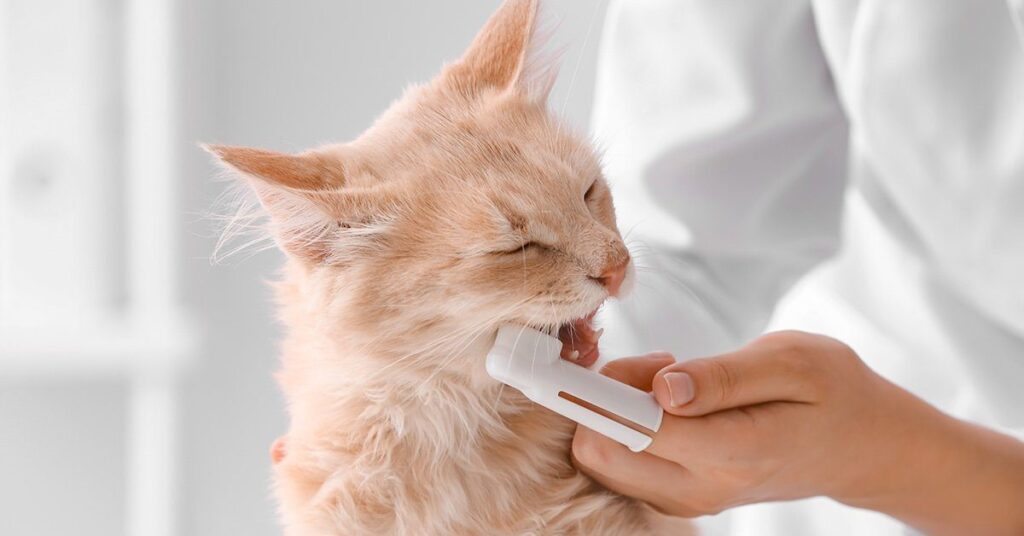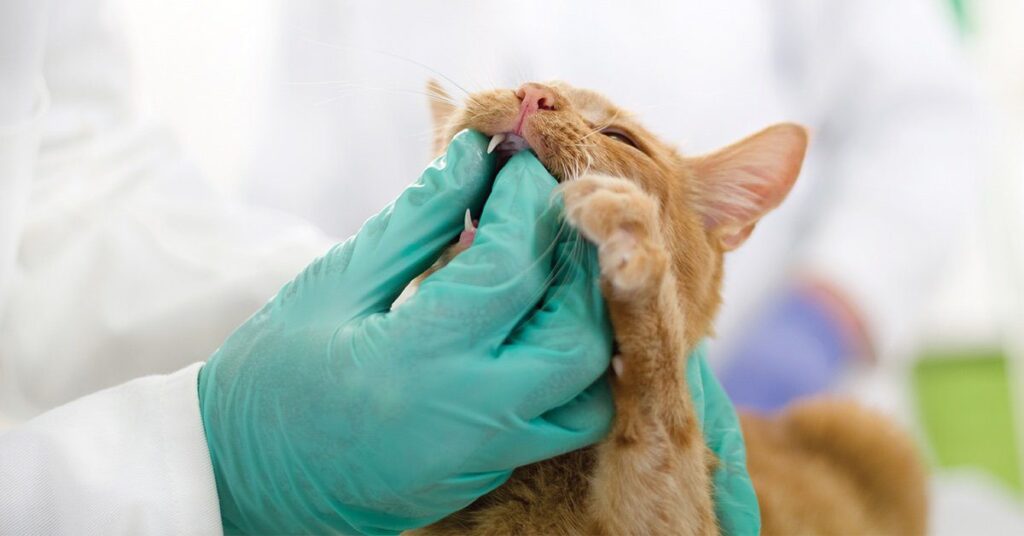Cats are known to be independent creatures, but when it comes to maintaining their dental health, they need a little help from their humans. Whether your cat is struggling with dental disease or you’re trying to adopt a good teeth brushing habit, cleaning your cat’s chompers is essential to their overall health and wellness.
Why cat teeth cleaning is important
All cats are obligate carnivores, meaning their diet consists of at least 70 percent meat. With this comes a set of sharp teeth, designed for ripping and tearing. Due to their unique shape, food can easily get caught between cats’ teeth and sit along their gum line.
Unlike wild cats who consume both fur and bone (which naturally keeps their teeth clean), domestic cats of all breeds are prone to developing dental issues if their teeth are not taken care of properly – just like us!
Dental diseases such as gingivitis and periodontal disease can be very painful for your cat, and if left untreated can lead to tooth loss and gradually damage their heart, kidneys, and liver. Additionally, feline tooth resorption can occur, which is the most common reason for tooth loss in cats, affecting 40% of adult cats.
In sum, cat dental care is a part of your new kitten checklist that shouldn’t be overlooked. It’s important for cat owners to understand that feline dental health isn’t much different from our own, and cleaning your cat’s teeth is the purrrfect way to prevent these diseases and keep your feline happy and healthy.
A closer look at cat dental care
Now that we’ve established why cat teeth cleaning is so important, let’s dive into the different methods for keeping your cat’s teeth clean.
1. Brush daily
Brushing a cat’s teeth is the gold standard and best way to prevent dental disease. The keys to cat teeth cleaning are starting young, having patience, and consistent repetition. The more you do it, the easier it will be! Although it’s best to start this process early in their life, there’s never a bad time to start brushing an adult cat’s teeth. Tacking dental care onto their grooming routine is a great way to stay consistent.
Try to make this activity fun by using flavored toothpaste, and remember to reward them afterwards with treats and love. Start by letting them lick toothpaste off your finger, and showing them the toothbrush so they can sniff it. Then, once they are comfortable with that, try gently massaging their gums with your finger to help them get used to this area being touched. If they don’t take well to a toothbrush, a bare finger, a finger covered in gauze or a dental wipe, or a finger brush may work better for you. Remember to never use human toothpaste because it contains fluoride, which is toxic to cats if they swallow it. Keep toothbrushing sessions short, and don’t worry if your cat doesn’t respond well to cat teeth cleaning at first. Be patient, go slow, stay positive, and you should eventually find success.

2. Provide treats and supplements
Dental treats and supplements are a great way to fight bacteria and tooth decay. These include oral rinses that you spray directly inside your cat’s cheek or rub along their gums with your finger, water additives that reduce plaque buildup, and dental treats that reduce plaque. Studies have shown that adding small amounts of powdered sea kelp (a few pinches) to food can reduce plaque-causing bacteria as well.
3. Maintain a healthy diet
Giving your cat a balanced diet will promote overall health, which bolsters the ability to fight disease – including dental diseases.
Cats with dental disease may be prescribed special food designed to reduce the growth of bacteria and plaque. As cats swallow most of their food whole, dental food is designed to be bigger to promote more chewing. Doing so creates friction which helps scrape plaque off of their teeth.
Check out this product list from the Veterinary Oral Health Council to find tested and approved dental products to help you maintain your cat’s oral health.
4. Keep up with veterinary checkups and dental cleanings
It’s very important to keep up with regular veterinary checkups every year. During these visits, your veterinarian will look at your cat’s teeth and gums to check for any signs of plaque, tartar, resorptive lesions, and periodontal disease. If they suspect an issue, or depending on your cat’s age, genetics, and overall health, they may advise yearly or twice-yearly dental exams.
During a dental exam, a veterinarian will use special tools to examine your cat’s teeth and jaw. Depending on those results, they may need to sedate your cat to get a more thorough look, and possibly take x-rays.
A professional teeth cleaning will remove plaque and tartar from your cat’s teeth, and will smooth out the surface of their teeth so plaque can’t stick as easily. During a cleaning, the veterinarian will also conduct a full oral examination, and recommend additional treatments as necessary. To ensure your cat is safe for general anesthesia, blood work will be run before your cat is sedated to make sure there are minimal risks with the procedure.

5. Watch out for signs of dental disease
While bringing your cat to veterinary checkups is important, it’s also important to be aware of changes in your cat’s behavior. Pawing at their mouth, drooling, eating less or only eating soft food, dropping food, red gums, and bad breath are all signs of dental disease. In addition, if your cat makes a ‘funny face’ after eating something cold, that is a telltale sign of dental pain. If you notice any of these signs, call your vet as soon as possible.
Dental coverage for cats
When in doubt, talk to your vet about how to best maintain your cat’s oral hygiene – they can help you come up with an at-home routine that works for you and your kitty. Explore our guide to find out more about how to take care of your cat’s dental health.
In the event that your cat does fall ill with gum disease, dental expenses can add up. That’s why Pumpkin’s Cat insurance plans can help pay for dental exams and prescriptions when they’re used to treat an illness like gum disease.
DISCLOSURE




